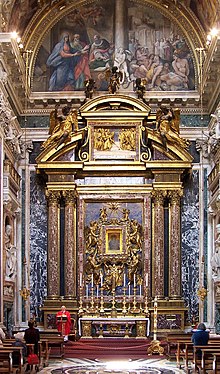Salus populi Romani
Salus populi Romani (Latin for "salvation of the Roman people") is the name used since the 19th century for an icon of the Mother of God , which is located in the Cappella Paolina of the Basilica of Santa Maria Maggiore in Rome. The Salus populi is the historically most important icon of Mary in Rome. The words Salus populi Romani go back to pagan Roman antiquity. After Christianity was recognized by the Edict of Milan in 313, Salus populi (“salvation of the people”) became an invocation of the Virgin Mary .
For centuries, the icon of the Salus populi Romani was placed above the door to the baptistery of the Basilica of Santa Maria Maggiore. In 1240 she was called Regina caeli (Queen of Heaven). She was later transferred to the nave of the church. The icon has been in a marble tabernacle since the 13th century. Since 1613 it has been in the altar of the Cappella Paolina , which was built especially for them. The icon has been considered miraculous since the 15th century at the latest. The icon is one of the so-called Luke pictures , which are believed to have been painted by the Evangelist Luke during the lifetime of Our Lady.
The dimensions of the icon are 117 × 79 cm. It is written on a thick tablet of cedar wood. Maria wears a gold-lined dark blue cloak over a purple tunic . The Greek letters above identify the sitter as the Mother of God. The baby Jesus holds a book in his left hand and is blessing with the right. The clasped hands of Mary distinguish this image as an early icon, before the type of Hodegetria developed further in the 10th century with Mary pointing to Christ with her right hand. She holds the child close to her and presents it less to the viewer than in other pictures of Mary. Since Maria is holding a Mappa (or Mappula , a type of embroidered ceremonial handkerchief) in her hand , which was considered an imperial symbol, her royal status as Regina caeli is emphasized, although she does not wear a crown. On the occasion of the Marian year 1953/54, which he announced with the encyclical Fulgens corona ("The radiant crown"), Pope Pius XII. the icon of the Salus populi Romani with a crown and a pectoral cross. The crown was later removed and is now in the sacristy of St. Peter's Basilica .
According to Gerhard Wolf's study , the painting in its original form can be dated to late antiquity. The current condition goes back to an overpainting in the 13th century, which followed several earlier revisions.
The early veneration of the image can be documented by the writing of further icons as early as the 8th century, as well as by her role on the Feast of the Assumption in Rome, where the icon of Mary was carried around the icon from the Lateran in a procession to Santa Maria Maggiore to meet the Salus populi Romani .
The icon was the preferred image of Mary by several popes. In 593 Pope Gregory the Great had them carried through Rome to pray for the end of the plague. In 1571 Pope Pius V prayed in front of the icon for victory in the Battle of Lepanto . In 1837 Pope Gregory XVI prayed . before her for the end of the cholera epidemic. Eugenio Pacelli (later Pope Pius XII) celebrated his primacy in front of this icon on April 3, 1899, one day after his ordination . In 1953 it was carried through Rome to inaugurate the first Marian year in church history. John Paul II gave a copy of the icon to the youth of the world, and has accompanied the World Youth Day Cross ever since . For the extraordinary donation of the Urbi et Orbi blessing on March 27, 2020 by Pope Francis during the COVID-19 pandemic , the icon of Mary was loaned to the Vatican and placed in front of St. Peter's Basilica and remained in St. Peter's Basilica for the following Easter celebrations on Maundy Thursday and Easter Sunday April 12, 2020.
literature
- Gerhard Wolf : SALUS POPULI ROMANI. The history of Roman cult images in the Middle Ages. VCH, Acta Humaniora, Weinheim 1990, ISBN 3-527-17717-5 (also: Heidelberg, Univ., Diss., 1989).


